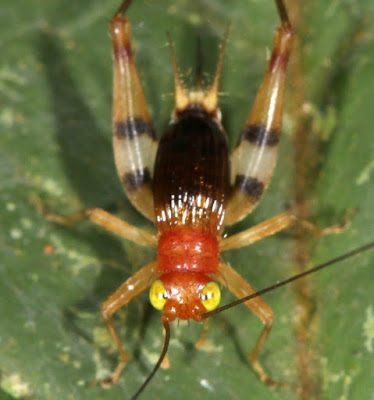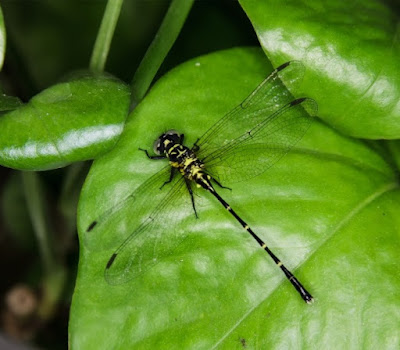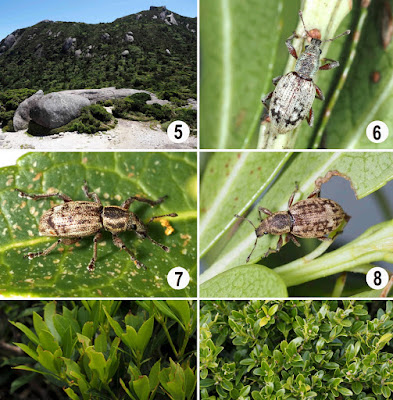[Most Recent Entries] [Calendar View]
Thursday, April 9th, 2020
| Time | Event | ||||
| 2:46a | [Entomology • 2020] A Taxonomic Study on the Bornean and Philippines Sword-tailed Crickets in the Genus Rhicnogryllus Chopard, 1925 (Orthoptera: Trigonidiidae; Trigonidiinae)
Abstract Rhicnogryllus Chopard, 1925 is a small and relatively unknown group of Sword-tailed Cricket of the subfamily Trigonidiinae. This genus currently comprises 12 species from Asia, Africa (including Madagascar), South America and the Pacific. Species have been recognised by the presence of parallel and elevated veins in both males (which lack stridulatory organs) and females. However, this approach to classifying Trigonidiinae may be outdated and examination of male genitalia can offer better insights into the generic status of these species and how they are related or unrelated. By comparing male genitalia of new materials and old specimens, we describe a new species from the Philippines: Rhicnogryllus? paetensis n. sp., which is similar to the type species. Our hypothesis is that Rhicnogryllus is a non-monophyletic and artificial genus, and that the genus should comprise only Southeast Asian members (since the type species Rhicnogryllus fascipes Chopard, 1925 is known from the Philippines). We are cautiously against describing new genus to avoid adding more confusion until a comprehensive revision to the subfamily and Rhicnogryllus has been undertaken. Keywords: Orthoptera, diagnosis, genitalia, new species, revision, Southeast Asia, taxonomy Tan Ming Kai, Jessica B. Baroga-Barbecho, Razy Japir, Arthur Y. C. Chung, Rodzay bin Haji Abdul Wahab and Sheryl A. Yap. 2020. A Taxonomic Study on the Bornean and Philippines Sword-tailed Crickets in the Genus Rhicnogryllus Chopard, 1925 (Orthoptera: Trigonidiidae; Trigonidiinae). Zootaxa. 4763(2); 217–230. DOI: 10.11646/zootaxa.4763.2.5 | ||||
| 3:27a | [Paleontology • 2020] Elessaurus gondwanoccidens • A New Archosauromorph from South America provides insights on the early Diversification of Tanystropheids
Abstract After the Permo-Triassic mass extinction, the archosauromorph fossil record is comparatively abundant and ecologically diverse. Among early archosauromorphs, tanystropheids gained considerable attention due to the presence of extreme skeletal adaptations in response to sometimes overspecialized lifestyles. The origin and early radiation of Tanystropheidae, however, remains elusive. Here, a new Early Triassic archosauromorph is described and phylogenetically recovered as the sister-taxon of Tanystropheidae. The new specimen, considered a new genus and species, comprises a complete posterior limb articulated with pelvic elements. It was recovered from the Sanga do Cabral Formation (Sanga do Cabral Supersequence, Lower Triassic of the Paraná Basin, Southern Brazil), which has already yielded a typical Early Triassic vertebrate assemblage of temnospondyls, procolophonoids, and scarce archosauromorph remains. This new taxon provides insights on the early diversification of tanystropheids and represents further evidence for a premature wide geographical distribution of this clade. The morphology of the new specimen is consistent with a terrestrial lifestyle, suggesting that this condition was plesiomorphic for Tanystropheidae. Systematic paleontology DIAPSIDA OSBORN, 1903 (SENSU LAURIN 1991) ARCHOSAUROMORPHA HUENE, 1946 (SENSU GAUTHIER ET AL. 1988) ELESSAURUS GONDWANOCCIDENS GEN. ET SP. NOV. Holotype: UFSM 11471 –A partially articulated hind limb associated with axial elements, composed of femur, tibia, fibula, pelvic girdle bones, sacral and caudal vertebrae, as well as an almost complete pes. Etymology: Genus named after Elessar, meaning ‘elf-stone’ in the fictional language Quenya, created by J. R. R. Tolkien. In Tolkien’s Middle Earth universe, Elessar Telcontar is the name chosen by king Aragorn II, who, by his turn, is also known as Strider or ‘longshanks’. The comparatively long zeugopodium of UFSM 11471 makes it a long-shanked animal, justifying the name. Termination -saurus from Greek, meaning ‘lizard’. Species name derived from the supercontinent Gondwana and the Latin adjective occidens, ‘from west’, in a reference to the locality from where the new species was recovered. Diagnosis: Elessaurus gondwanoccidens differs from all other archosauromorphs based upon a unique combination of characters: second sacral vertebral rib elongated and distally bifurcated, with a robust articular surface; transverse processes of the caudal vertebrae inclined posterodorsally; strongly sigmoidal femur; tibia and fibula longer than femur; metatarsals increase in size from the first to the fourth toe; fifth metatarsal short, with a proximal hook-shaped end; presence of a calcaneal tuber. Locality and horizon: The specimen was collected at the locality known as Bica São Tomé, Sanga do Cabral Formation (Sanga do Cabral Supersequence, Paraná Basin), municipality of São Francisco de Assis, Rio Grande do Sul, Southern Brazil (Fig 1). Elessaurus gondwanoccidens was collected in one of the five outcrops comprising the Bica São Tomé (outcrop 5 of Da-Rosa et al. [2009]). An Induan-Olenekian age (251–247 Ma) [Cohen et al 2013.] is inferred for this formation based on the presence of the parareptile Procolophon trigoniceps Owen, 1876, and comparisons with the Lystrosaurus Assemblage Zone of the South African Karoo Basin. Elessaurus gondwanoccidens represents the most complete postcranial skeleton so far recovered from this unit, as Sanga do Cabral fossils are often fragmentary, with rare occurrences of associated elements. Description and comparison: Elessaurus gondwanoccidens holotype is composed of an almost complete hindlimb associated with pelvic girdle bones and partially articulated sacral and caudal vertebrae (Fig 2). Although some elements show signs of compression (e.g. femur, tibia), all bones are close to a natural position, except for a slight displacement of some tarsal elements and distal phalanges missing in most digits. As will be discussed, the specimen is morphologically compatible with basal archosauromorphs, especially with Tanystropheidae. ....
Conclusions: Until recently, the Sanga do Cabral Formation provided only few remains assigned to Archosauromorpha indet. Now, at least two independent lineages were reported for this unit. Although rare, these fossils demonstrate that archosauromorphs had already diversified in the Early Triassic of western Gondwana. Elessaurus gondwanoccidens is here recovered as the sister taxon of Tanystropheidae and was collected from rocks reminiscent of continental environments dominated by ephemerous water bodies. Most representatives of Tanystropheidae (e.g. Tanystropheus) belong to marine environments. The results of the present work suggest that a terrestrial mode of life was plesiomorphic for Tanystropheidae and maintained by some of its representatives (e.g. Macrocnemus). The record of Tanystropheidae-related taxa in Permian and Lower Triassic layers from South America indicates a premature wide distribution of this clade, with a possible Gondwanan origin. Tiane M. De-Oliveira, Felipe L. Pinheiro, Átila Augusto Stock Da-Rosa, Sérgio Dias-Da-Silva and Leonardo Kerber. 2020. A New Archosauromorph from South America provides insights on the early Diversification of Tanystropheids. PLoS ONE. 15(4): e0230890. DOI: 10.1371/journal.pone.0230890 | ||||
| 4:16a | [Entomology • 2020] Stylogomphus thongphaphumensis • A New Gomphid Dragonfly (Odonata: Anisoptera: Gomphidae) and the First Record of S. malayanus from Thailand
Abstract Stylogomphus thongphaphumensis sp. nov. is described from a type series of specimens reared from larvae (holotype ♂, Huai Khayeng, Thong Pha Phum district, Kanchanaburi Province; ..., 206 m a.s.l., larva collected on 14.XII.2014; adult emerged on 30.IV.2015). All larvae were collected from the same locality in western Thailand. Description of the larva (based on preserved exuviae) is provided as well. The adult of this species can be distinguished from other Stylogomphus Fraser, 1922, by the morphology of the male anal appendages, pterothoracic pattern, abdominal pattern, male genitalia and female valvula vulvae (detail provided in the differential diagnosis below). This is the first species of Stylogomphus to be described from Thailand. This study also reports the first record of Stylogomphus malayanus Sasamoto, 2001, from Thailand. Keywords: Odonata, Gomphidae, Stylogomphus, Thailand
Damrong Chainthong, Michel Sartori and Boonsatien Boonsoong. 2020. Stylogomphus thongphaphumensis (Odonata: Anisoptera: Gomphidae), A New Gomphid Dragonfly and the First Record of S. malayanus Sasamoto, 2001 from Thailand. Zootaxa. 4763(2); 231–245. DOI: 10.11646/zootaxa.4763.2.6 ...รายงานในวารสาร Zootaxa ประเทศไทยมีแมลงปอเสือปลายงอน 2 ชนิดคือ แมลงปอเสือปลายงอนทองผาภูมิ (Stylogomphus thongphaphumensis) ที่เป็นชนิดใหม่ และแมลงปอเสือปลายงอนถิ่นใต้ (Stylogomphus malayanus) ที่เป็นรายงานใหม่ของประเทศ (จากเดิมเจอแค่ที่ประเทศมาเลเซีย) นับเป็นการค้นพบที่น่าตื่นเต้นทีเดียว... | ||||
| 7:29a | [Entomology • 2020] Amystax urara • A New Species of Amystax Roelofs, 1873 (Coleoptera: Curculionidae: Entiminae) endemic to the Mountainous Area of the Yakushima World Natural Heritage Site, Kyushu, Japan
Abstract Amystax urara Kojima and Yôro, sp. nov. is described from the mountainous area of the Yakushima World Natural Heritage island, Kyushu, southwestern Japan. Adult weevils were captured on leaves of Pieris japonica var. yakushimensis and Buxus microphylla var. japonica (Ericaceae and Buxaceae, respectively). This is the second species of this genus known from the island. Key word: taxonomy, new taxa, Entiminae, Tanymecini, species discovery
Amystax urara Kojima and Yôro, sp. nov. Etymology. “Urara” means beautiful things in Japanese, and is also the name of our close associate on Yakushima Island, Mrs. Urara Ogata of the Riverside Café Bar, St. Pote. The brownish gray to ash green lustrous scales of this species make it the brightest species in the genus Amystax. Biology. Adults were found on the leaves of Pieris japonica var. yakushimensis T. Yamaz. and Buxus microphylla var. japonica (Müll. Arg. ex Miq.) Rehder et E.H.Wilson from June to the middle of August. They were not found in October at the type locality. Adults are common in July and their feeding scars were observed on leaf margins of the aforementioned shrubs (Figs. 9 & 10). The microhabitat of this weevil seems to be restricted to shrubs on nearly flat or gently sloping areas at the type locality; no adults were found on shrubs on slopes. The type locality, Nageishidaira, is a relatively flat, rocky site, ca. 1,700 m a.l.s, with low-growing shrubs such as R. yakushimanum, P. japonica var. yakushimensis, Buxus microphylla var. japonica (Tsuge in Japanese; Buxaceae), etc. Weevils appeared to associate with, not only P. j. var. yakushimensis, but also B. m. var. japonica. Distribution. Japan (Kyushu: mountainous area on Yakushima Island). Hiroaki Kojima and Takeshi Yôro. 2020. A New Species of Amystax Roelofs, 1873 endemic to the Mountainous Area of the Yakushima World Natural Heritage Site, Kyushu, Japan. Zootaxa. 4732(3); 495–500. DOI: 10.11646/zootaxa.4732.3.12 |
| << Previous Day |
2020/04/09 [Calendar] |
Next Day >> |







